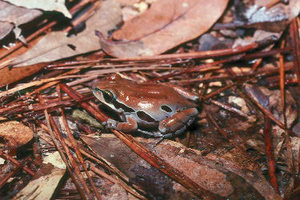As is true of many amphibians, the breeding characteristics of ornate chorus frogs are fairly well documented, but their habits in nonbreeding upland habitats are poorly known.
Photo Credit: USGS
Pseudacris ornata
Common Name: ornate chorus frog
Animal Guild: Amphibian
Class > Order > Family: Amphibia > Anura > Hylidae
What does the species look like?
Adults have across each eye a black masklike stripe that may extend along the side of the body. The sides of the body and area near the groin have distinct light-bordered black spots. The groin is yellow. The upper side of these frogs is often reddish brown or green but can range from blackish to silvery white. Maximum size is about 1.5 inches (3.9 cm) snout-vent length. Juveniles have a less distinct pattern than do adults. Breeding males have a dark throat. The breeding call is a series of high peeps (1-1.5 peeps per second). Larvae have a very high tail fin that begins just behind the eyes, and there is often a gold or brassy stripe along each side of the back. Larvae grow up to about 1.7 inches (4.3 cm) long.
Where is the species found?
States & Provinces
AL, FL, GA, LA, MS, NC, SC
Distribution
Range includes the Coastal Plain from North Carolina to central Florida, and west to southeastern Louisiana.
Ornate chorus frogs inhabit sandhills, pine flatwoods, upland pine forests, and other habitats within several hundred meters of their breeding pools. They burrow into the ground (often among herbaceous plant roots) when not active on the surface. Adults are seldom observed except when breeding. Eggs are attached to plant stems in flooded fields, sinkhole ponds, pine barren ponds, Carolina bays, and cypress ponds
General Phenology and Life History
Clusters of usually a few dozen eggs are laid from late fall to early spring (peak usually in winter). Larvae hatch in about a week and metamorphose into small frogs about 3-4 months later. Little or no recruitment occurs during drought periods.
Which phenophases should I observe?
Do you see/hear...?
Activity
Adults on land More...
For abundance, enter the number of individual animals observed in this phenophase.
Adults in water More...
For abundance, enter the number of individual animals observed in this phenophase.
Adults feeding For abundance, enter the number of individual animals observed in this phenophase.
Reproduction
Vocalizing What is the intensity of vocalizing?
Single calls: There is space between calls and individuals can be counted. Overlapping calls: Calls of individuals can be distinguished but there is some overlapping of calls. Full chorus: Calls are constant and overlapping.
Mating For abundance, enter the number of individual animals observed in this phenophase.
Fresh eggs For abundance, enter the number of individual animals observed in this phenophase.
Development
Dead adults For abundance, enter the number of individual animals observed in this phenophase.
What do these phenophases look like?
There is currently no photoguide available for this species. If you'd like help us create one, use the guidance document and species template provided here . Then send it via email to education@usanpn.org when it is complete.
